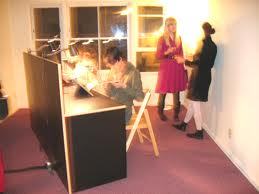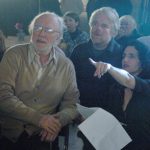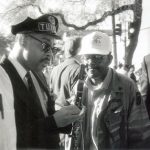The Business of Art: A Conversation with Kathryn Andrews
Friend: How did APARTMENT 2 begin?
Kathryn Andrews: It started one night a couple years ago when I got fed up with my living room furniture.
F: How so?
KA: Well, some years before, when I’d moved to Los Angeles to go to graduate school, I’d picked up a den and dining room set that proved to be embarrassing over time.
F: Why?
KA: It embodied a funny mix of my being broke but having a fresh-to-California fantasy of living the locale’s mid-century dream of a minimalist utopia.
F: What did this look like?
KA: Modernism-for-the-masses to the max. Faux-metal surfaces. Veneer-covered foams. Oh yeah, there was a lot of plastic designed to look like glass. People would come over and make fun of it.
F: So what happened?
KA: At the time, in both my apartment and studio, I was moving things around a lot—furniture, sculptural fragments, paper cutouts—to think about how objects could function in three-dimensional spaces while creating certain optical effects. At some point I determined my living room furniture, with its material aspirations being other than straightforward, arrested the eye in weird ways, preventing a visual fluidity that interested me. I decided to sell everything and start over.
F: When you did this were you planning to convert your living space into a gallery?
KA: No, that came later.
F: When?
KA: Some friends gave me the idea in mid-2006, when I was in a creative lull.
F: Why were you in a lull?
KA: The way I’d been making stuff wasn’t adding up. My process was completely impractical. And its results weren’t at all indicative of my main interest as an artist—exposing the oddities of how aesthetic decisions are made.
F: Can you describe your process at that point?
KA: For several years I’d been making hundreds of paintings and sculptures and destroying them. I would take each one apart and rearrange it many times as a way of coping with an anxiety about why given elements in formally abstract works look any particular way.
F: What do you mean?
KA: What I’m talking about is how, in some works of art, there are components that are key to the effect of the whole, but there are also often what I’d call “peripheral” components—marks or forms that if slightly altered would not largely impact a work’s gestalt.
F: What does this idea of peripherals have to do with what you mentioned before, how you destroyed your own work?
KA: I’ve always been interested in the degree of difference a work could withstand without its meaning being radically altered. Like, “Why does this work look this way? If it looked slightly different, what would be the fallout”?
F: So you reconfigured your own works to find out?
KA: Yes. From roughly 2002 to 2006, I hacked up sculptures and paintings I’d made to determine which parts might be unnecessary. Expendable. I wanted to arrive at a work where every element seemed justified by an interdependency with others. I was trying to get away from, “This thing is here because I say so. I’m the artist. And you, the viewer, have to deal with whatever I put before you, whether or not it makes sense.”
F: Did you succeed?
KA: No. Ultimately, I realized I would never make a work where some aspect of its appearance didn’t seem incidental. Certain physical characteristics would always be determined by a chance event beyond my control. Or, once I was deep into the process of making a work, choices I’d made early on, or that had been dictated by circumstance, would no longer gel, yet they’d be irrevocable.
F: So you turned to showing other people’s work instead of your own?
KA: Temporarily, while I was devising another methodology. For the most part, I needed relief from publicly associating myself with works toward which I felt a lot of ambivalence.
F: What do you mean?
KA: Immediately after school I didn’t exhibit widely, but occasionally when I’d be asked to show something, in order to meet the deadline, I’d make a false stopping point. I’d show a work in whatever state it was in, though I usually felt uncomfortable about it being perceived as static, as if I were invested in its particular incarnation.
F: How do you see the shows you’ve done in the apartment space as relating to this history?
KA: They do directly. If you think about what I’ve been asking—what constitutes the core of a work and what acts as its container (the latter being conceptualized in a very loose sense)—the apartment space is a perfect battleground. It allows for variability over time as different shows happen within. Its chaos, unlike a standardized gallery or museum white cube, explicitly forces a question about framing. Exhibiting artists and visitors have to struggle to locate and define the work. Where is it? What is it? How is it divisible from its context? What are its meanings when spread through many rooms, when adjacent to a pink bedspread that accentuates its color, when in the non-neutral zone of furniture and books and artworks made by Kathryn Andrews’ friends?
F: Speaking of friends, do visitors to the space become part of “the frame”?
KA: Absolutely.
F: Who comes?
KA: All sorts of people. Neighbors dropping by with food who have little interest in contemporary art. My church-going landlord who’s averse to wild openings. Hundreds of artists from L.A., New York, and Europe who’ve heard of the space by word of mouth. Local gallerists, critics, the occasional museum curator. People who saw our ad in LA Weekly.
F: How is the social apparatus of APARTMENT 2 different from that of any other gallery?
KA: It’s not. Every space has a social and professional network that influences the perception of what it exhibits. Here there’s simply less pretense of neutrality, which in turn makes these networks obvious, asking them to be considered in relation to the art.
F: It sounds like the autonomy of the exhibiting artist’s work is at stake once it enters your space, particularly since you’re an artist and the space itself could possibly be viewed as art.
KA: This is true. But autonomy is always an illusion. Every time an artist exhibits, his or her oeuvre takes on new meaning through that association and the venue’s identity is reciprocally altered. Again, I was interested in making this sort of thing explicit by creating a situation that is more charged, that forces a double-take.
F: How have exhibiting artists responded to the setting?
KA: The two L.A. artists I’ve shown, Benjamin Lord and Dawson Weber, are invested in questions of context and used the space to really push that point.
F: How so?
KA: Lord took advantage of the apartment’s intimacy to exhibit stereograms that required a slowed-down kind of looking. He exhibited these on a table designed for the space alongside an album embossed with a fictional text that functioned as an allegory for the oddity of seeing in 3-D.
F: And Weber?
KA: Weber made work about bridging which he placed in multiple rooms. Some pieces directly referenced bridges. Others indirectly. The viewer was left to find the work, to distinguish it from competing visual stimuli, and to connect Weber’s diverse strategies of artmaking, which ranged from appropriation to gestural painting.
F: Will you host future exhibitions?
KA: Yes, but to date I’ve hosted only one a year due to the way the space is funded—through my day job—and due to personal time constraints.
F: Why don’t you run the space as a more commercial enterprise or as a non-profit?
KA: I’ve enjoyed the implications of it being self-funded. What can happen isn’t as limited by a need to be fiscally responsible. If something sells, cool. If not, cool. I pay the rent to live there, so it really doesn’t matter. Also, independence allows me to show tough work by emerging artists that can be slow to enter the marketplace.
F: Do you think the artists you’ve worked with will become important on the L.A. scene?
KA: Absolutely. Both Lord and Weber have been influenced by and are expanding upon a local history. They’ve yet to be valued by commercial venues. But based on the number of people who’ve come to see their shows at APARTMENT 2, they clearly have a large underground following.
F: Do you think the space is understood as participating in the marketplace in a reactionary way?
KA: I do. That someone could come here and have a transformative experience and then head over to 6150 Wilshire or Gagosian Gallery in Beverly Hills… that’s completely hilarious. That something in my bedroom could garner critical attention and enter the annals of art history as easily as any other show in town… it’s a coup.
F: So you’re in it for the laughs?
KA: Nah, I was sort of teasing. Ultimately, everything gets framed in terms of the market. What interests me is that brief moment before things get pinned down, when someone could think, “This work isn’t justified because it’s here to sell. It’s justified because I’m here looking at it.”
F: Or, “We’re all here looking at it and our reasons for coming are very personal?”
KA: Exactly.
F: As are our ways of seeing?
KA: Exactly. I couldn’t have said it better.
Kathryn Andrews is a Los Angeles-based artist who also writes and curates. Andrews received a BA from Duke University and an MFA from Art Center College of Design. She has recently exhibited work at Michael Kohn Gallery and Jack Hanley Gallery, both in Los Angeles. In 2007 she completed a collaborative project with Alice Könitz and Stephanie Taylor for Courtyard Gallery, Beijing, and Daniel Hug Gallery, Los Angeles. She is presently editing Modern Lovers, a book of interviews with ten L.A. artists (forthcoming from North Fig Press in 2008) and has writing featured in the current issue of the new L.A.-based language arts journal Area Sneaks.
For more on APARTMENT 2, visit http://apartment2.wordpress.com.





